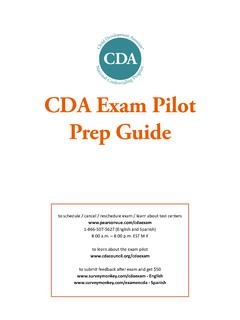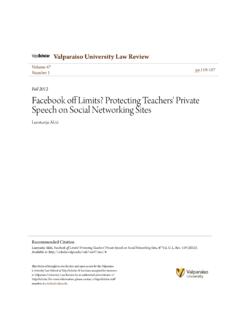Transcription of HIGH-QUALITY INFANT/TODDLER EDUCATORS NEED GOOD …
1 Visit our website: or follow us on social media : PD Specialists: Customer Support: INFANT/TODDLER EDUCATORS NEED GOOD Public Investment Also Promotes Child Development and Makes Early Education Accessible1 One of the most important periods in a person s life cycle to stimulate learning occurs between birth and age However, there are considerable gaps in the United States between what infants and toddlers need for successful development and what is available from well-trained, qualified EDUCATORS and what is accessible to parents of very young white paper examines the learning and social-emotional needs of infants and toddlers and the training requirements and needs of the early childhood professionals who educate and care for them. It highlights the known gaps between their needs and the current state of early childhood education in the United States and what can be done to bridge those gaps.
2 The nature of educational preparation and skill development for the INFANT/TODDLER educator workforce has evolved in response to new research on the brain development of children from 0 to 3 that reinforces how crucial these years are for cognitive, social and emotional, language, and physical paper moves from making the case for HIGH-QUALITY learning for infants and toddlers to evaluating the availability and accessibility of such early childhood education for American families from different socioeconomic, racial and ethnic, and geographical backgrounds. High costs and the dearth of public support and community resources are one set of factors responsible for these gaps. The low status and uneven preparation of INFANT/TODDLER EDUCATORS are also contributing factors. The paper makes the argument for better training and professional development and for the important role that the Child Development Associate (CDA) credential , awarded by the Council for Professional Recognition (the Council), plays in ensuring HIGH-QUALITY EDUCATORS for children between 0 and 3.
3 It illustrates how early childhood EDUCATORS who have earned an INFANT/TODDLER CDA are trained in the competencies for professional practice that nourish brain development and apply the developmentally appropriate teaching strategies for infant-toddler or other age-appropriate settings. Examples of promising INFANT/TODDLER education initiatives around the country also are PAPERV isit our website: or follow us on social media : PD Specialists: Customer Support: EARLY CHILDHOOD EDUCATION IS SO IMPORTANTD uring children s first three years of life, their brains are rapidly wired with most of the neurons they will have as an adult. These neurons process information flowing from one neuron to another across a synapse. Synapses are the basis for learning and memory. Neuroscience has shown that a 3-year-old typically has twice as many synapses as an adult.
4 In addition to rapid brain development, a multitude of factors in a child s environment influences early cognitive, physical, and psychosocial development, according to psychologists like Urie Bronfenbrenner, who emphasized the ecology of human development. These are key years for an infant or toddler to learn how to interact with others, and develop self-awareness, empathy, trust, and other psychosocial aspects of human development. Recognition of the developmental importance of these years has pushed the frontier of school readiness from preschool to the INFANT/TODDLER period, as the Network of INFANT/TODDLER Researchers Research clearly indicates that interactions with parents, EDUCATORS , and others matter profoundly from birth to age 3, and the caliber of infants or toddlers daily interactions with an early childhood educator has the potential to impact their brain structure throughout their lifetime.
5 Because the infant and toddler years are so critical to child development, it is essential that all very young children have access to HIGH-QUALITY care and education and that their EDUCATORS have the knowledge, competencies, and sensitivities to best meet infants and toddlers needs. Unfortunately, these are areas in which the United States is particularly YEAR1-2 YEARS2-3 YEARSV isit our website: or follow us on social media : PD Specialists: Customer Support: AND BARRIERS TO INFANT/TODDLER CARE AND EDUCATIONA pproximately 12 million Americans were between the ages of 0 and 3 in 2016. Of these, about million were white, million are Hispanic, about million were black, more than half a million were Asian, and about 120,000 were American Indian, Alaskan Native, Native Hawaiian or Pacific Islander.
6 Infants and toddlers are more likely to be poor than the general population, with 24 percent living in poverty and 47 percent in near poverty households with incomes below 200 percent of the federal poverty threshold in Although countries like Denmark and the Netherlands enroll 50-65 percent of their 0-to-2-year-olds in formal care, estimates of infant-toddler enrollment in center- or home-based settings in the United States range from one-third to one-half. In France, early childhood education is essentially free for parents, whereas the average annual cost of center-based care in the United States for an infant was higher than in-state tuition at a four-year public college in 28 states and the District of Columbia, according to Child Care Given the high costs and the lack of sufficient government support for early childhood education for American families, access is heavily, and sadly, dependent on household income and geography.
7 Fewer than one in five low-income infants, toddlers, as well as children of preschool age, are enrolled in HIGH-QUALITY early childhood education, and nearly half as many young children in rural areas are enrolled, compared to those in urban and suburban areas. Head Start (including Early Head Start), the Child Care Development Block Grant, and other federal programs serve or fund only a small fraction of young children who are eligible, and the quality of programs tends to be poorer for those from low-income backgrounds. For example, at Washington, DC s Barbara Chambers Children s Center, only children of parents with incomes below the poverty level are eligible, yet there were 122 on the waiting list for 28 slots in early 2018, according to director Sonia Di-majo. At another publicly funded center, at Bell Multicultural High School in Washington, five of the 40 young children have high-school-age parents, two have incarcerated fathers, two live in homeless shelters, and many of the rest come from single-parent households, according to director Anna Ayala.
8 As a result, poor children and children of color are generally at a significant disadvantage before they even enter Fewer than 1 in 5 low-income infants, toddlers, as well as children of preschool age, are enrolled in HIGH-QUALITY early childhood our website: or follow us on social media : PD Specialists: Customer Support: WORK OF INFANT/TODDLER EDUCATORSThe work of an INFANT/TODDLER educator is clearly of vital importance to children in their first three years of life and can be enormously rewarding, yet it is also hard work, at low pay, and generally accorded little social respect. Every day, in homes and centers across the country, two million or more adults are paid to care for and educate children between birth and age five, with half or more working with infants and At the Barbara Chambers center, 12 infants between zero and 16 months sit at low tables finger-painting, as middle-aged women guide their hands, talk to them, and watch out for their safety.
9 The walls are adorned with painted trees with multi-colored leaves, and cribs stand in the corner for naptime. The room is also filled with toys and cabinets and simple phrases on the walls in Spanish and work is a far cry from babysitting. First, I observe the children to know them, Mara Hernandez, a teacher with a CDA credential who has spent more than six years working with in INFANT/TODDLER centers and preschools and 10 years with older children, said. It s important to make a connection with them. We talk to their parents to learn more about them and ask them to bring in pictures or a scarf or something to make a connection with home. We see what skills they need to develop and we make individualized lessons plans for each child. 7 Ms. Ayala agrees that teaching must be intentional, geared to the individual child and parents need to be engaged with her dozen multilingual teachers and staff.
10 As a saying on the wall proclaims: We are like a box of crayons. Each one of us is unique. Interactions and relationships between EDUCATORS and very young children are extremely important since these are the adults who often spend as much or more time with infants and toddlers than their parents do on the days that children are at with toddlers at the Bright Horizons Child Development Center in New Brunswick, , Emily Urbanski, who earned a CDA credential, said: I read with children, ask questions during the story that are open-ended to encourage conversations, and I also let them tell a story based on the illustrations in the book. A center assistant director at Bright Horizons in Rochester, Minn., Teresa Larson, who also has a CDA, works hard to learn about each child and her needs.

















